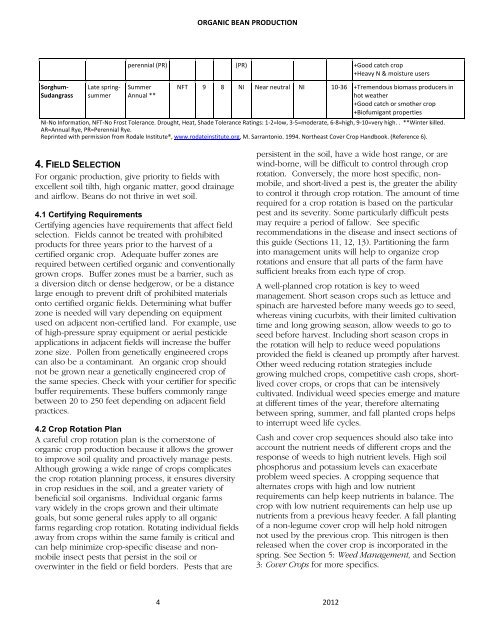beans 4-24-12 CLEAN - Vegetableipmasia.org
beans 4-24-12 CLEAN - Vegetableipmasia.org
beans 4-24-12 CLEAN - Vegetableipmasia.org
Create successful ePaper yourself
Turn your PDF publications into a flip-book with our unique Google optimized e-Paper software.
ORGANIC BEAN PRODUCTION <br />
S<strong>org</strong>hum-‐<br />
Sudangrass <br />
Late spring-summer<br />
<br />
perennial (PR) (PR) +Good catch crop <br />
+Heavy N & moisture users <br />
Summer <br />
Annual ** <br />
NFT 9 8 NI Near neutral NI 10-‐36 +Tremendous biomass producers in <br />
hot weather <br />
+Good catch or smother crop <br />
+Biofumigant properties <br />
NI-‐No Information, NFT-‐No Frost Tolerance. Drought, Heat, Shade Tolerance Ratings: 1-‐2=low, 3-‐5=moderate, 6-‐8=high, 9-‐10=very high. . **Winter killed. <br />
AR=Annual Rye, PR=Perennial Rye. <br />
Reprinted with permission from Rodale Institute®, www.rodateinstitute.<strong>org</strong>, M. Sarrantonio. 1994. Northeast Cover Crop Handbook. (Reference 6). <br />
4. FIELD SELECTION<br />
For <strong>org</strong>anic production, give priority to fields with<br />
excellent soil tilth, high <strong>org</strong>anic matter, good drainage<br />
and airflow. Beans do not thrive in wet soil.<br />
4.1 Certifying Requirements<br />
Certifying agencies have requirements that affect field<br />
selection. Fields cannot be treated with prohibited<br />
products for three years prior to the harvest of a<br />
certified <strong>org</strong>anic crop. Adequate buffer zones are<br />
required between certified <strong>org</strong>anic and conventionally<br />
grown crops. Buffer zones must be a barrier, such as<br />
a diversion ditch or dense hedgerow, or be a distance<br />
large enough to prevent drift of prohibited materials<br />
onto certified <strong>org</strong>anic fields. Determining what buffer<br />
zone is needed will vary depending on equipment<br />
used on adjacent non-certified land. For example, use<br />
of high-pressure spray equipment or aerial pesticide<br />
applications in adjacent fields will increase the buffer<br />
zone size. Pollen from genetically engineered crops<br />
can also be a contaminant. An <strong>org</strong>anic crop should<br />
not be grown near a genetically engineered crop of<br />
the same species. Check with your certifier for specific<br />
buffer requirements. These buffers commonly range<br />
between 20 to 250 feet depending on adjacent field<br />
practices.<br />
4.2 Crop Rotation Plan<br />
A careful crop rotation plan is the cornerstone of<br />
<strong>org</strong>anic crop production because it allows the grower<br />
to improve soil quality and proactively manage pests.<br />
Although growing a wide range of crops complicates<br />
the crop rotation planning process, it ensures diversity<br />
in crop residues in the soil, and a greater variety of<br />
beneficial soil <strong>org</strong>anisms. Individual <strong>org</strong>anic farms<br />
vary widely in the crops grown and their ultimate<br />
goals, but some general rules apply to all <strong>org</strong>anic<br />
farms regarding crop rotation. Rotating individual fields<br />
away from crops within the same family is critical and<br />
can help minimize crop-specific disease and nonmobile<br />
insect pests that persist in the soil or<br />
overwinter in the field or field borders. Pests that are<br />
persistent in the soil, have a wide host range, or are<br />
wind-borne, will be difficult to control through crop<br />
rotation. Conversely, the more host specific, nonmobile,<br />
and short-lived a pest is, the greater the ability<br />
to control it through crop rotation. The amount of time<br />
required for a crop rotation is based on the particular<br />
pest and its severity. Some particularly difficult pests<br />
may require a period of fallow. See specific<br />
recommendations in the disease and insect sections of<br />
this guide (Sections 11, <strong>12</strong>, 13). Partitioning the farm<br />
into management units will help to <strong>org</strong>anize crop<br />
rotations and ensure that all parts of the farm have<br />
sufficient breaks from each type of crop.<br />
A well-planned crop rotation is key to weed<br />
management. Short season crops such as lettuce and<br />
spinach are harvested before many weeds go to seed,<br />
whereas vining cucurbits, with their limited cultivation<br />
time and long growing season, allow weeds to go to<br />
seed before harvest. Including short season crops in<br />
the rotation will help to reduce weed populations<br />
provided the field is cleaned up promptly after harvest.<br />
Other weed reducing rotation strategies include<br />
growing mulched crops, competitive cash crops, shortlived<br />
cover crops, or crops that can be intensively<br />
cultivated. Individual weed species emerge and mature<br />
at different times of the year, therefore alternating<br />
between spring, summer, and fall planted crops helps<br />
to interrupt weed life cycles.<br />
Cash and cover crop sequences should also take into<br />
account the nutrient needs of different crops and the<br />
response of weeds to high nutrient levels. High soil<br />
phosphorus and potassium levels can exacerbate<br />
problem weed species. A cropping sequence that<br />
alternates crops with high and low nutrient<br />
requirements can help keep nutrients in balance. The<br />
crop with low nutrient requirements can help use up<br />
nutrients from a previous heavy feeder. A fall planting<br />
of a non-legume cover crop will help hold nitrogen<br />
not used by the previous crop. This nitrogen is then<br />
released when the cover crop is incorporated in the<br />
spring. See Section 5: Weed Management, and Section<br />
3: Cover Crops for more specifics.<br />
4 20<strong>12</strong>




![Section 4 [ PDF file, 252 KB] - The Field Alliance](https://img.yumpu.com/51387260/1/158x260/section-4-pdf-file-252-kb-the-field-alliance.jpg?quality=85)












